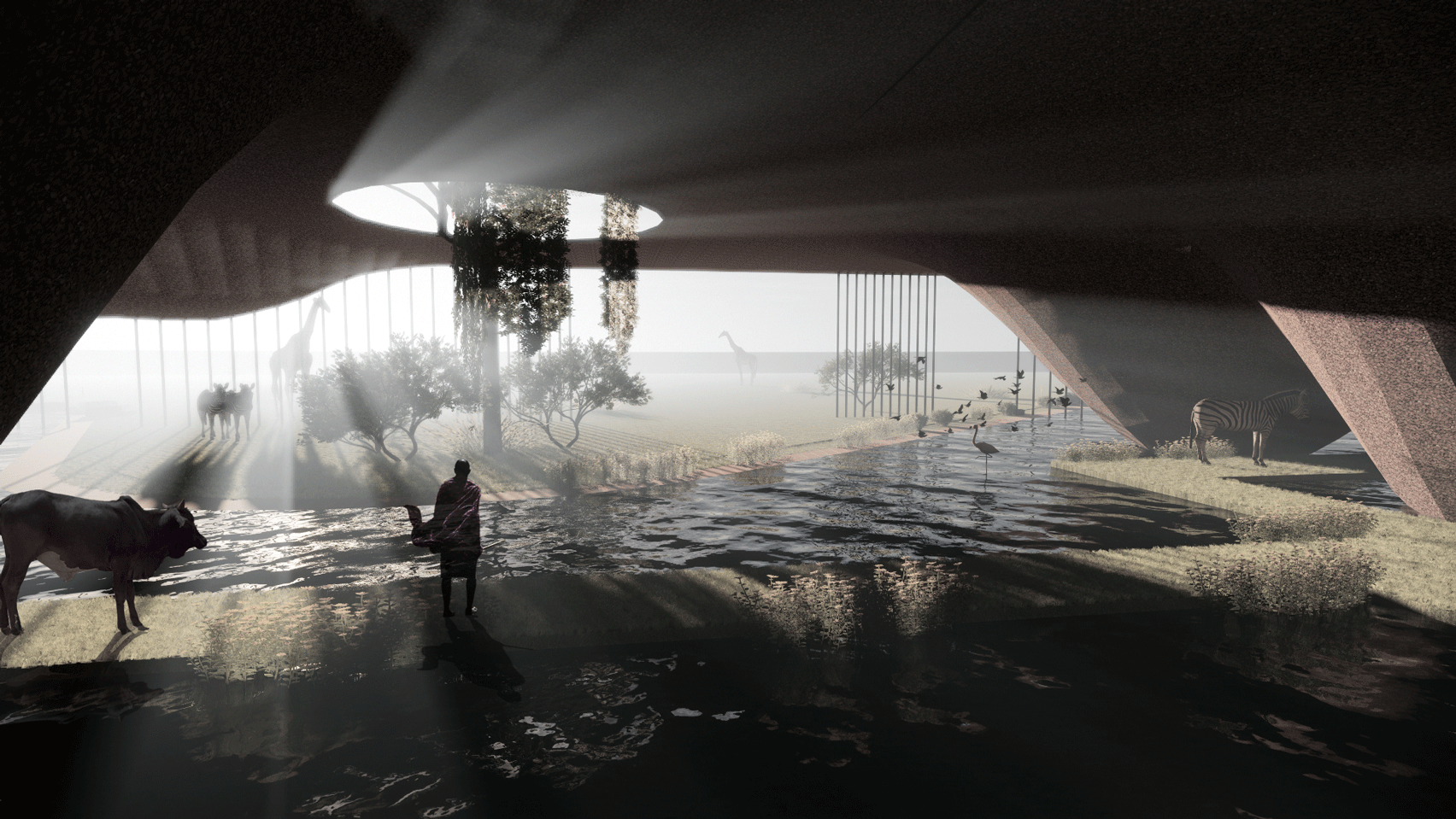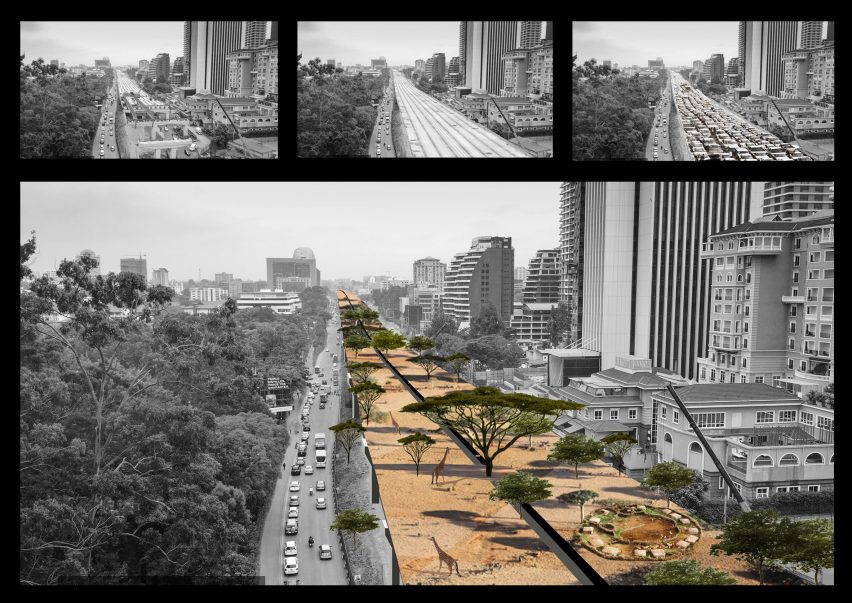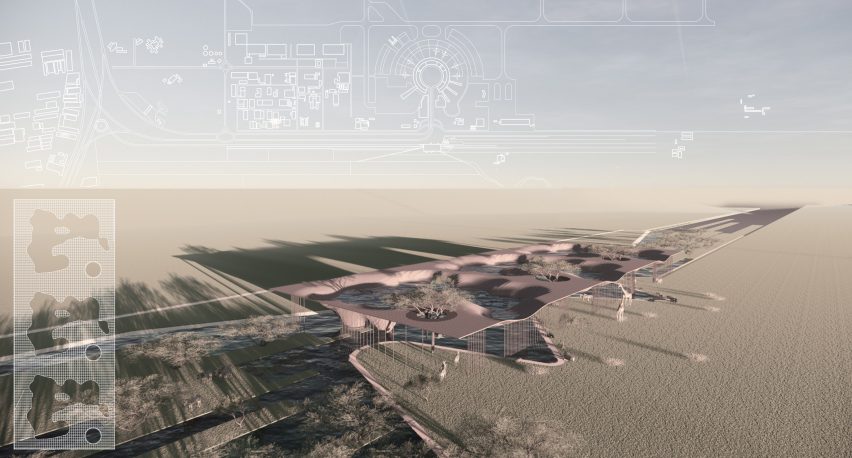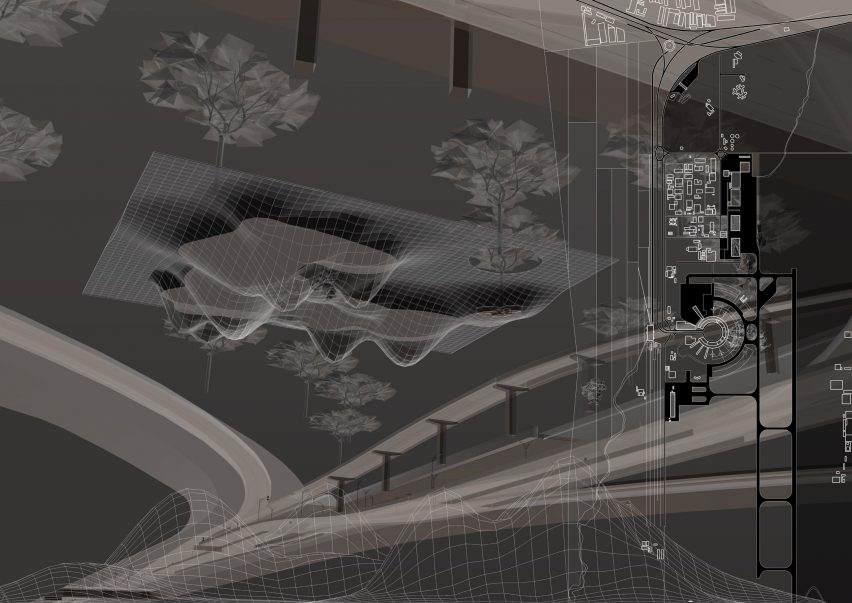
Cave Bureau proposes "a new kind of infrastructure for the first inhabitants of the city"
Maasai people could once again legally herd their cattle through Nairobi via Cow Corridors proposed by Cave Bureau in this manifesto prepared for the Dezeen 15 digital festival.
"We imagine a new kind of infrastructure we call Cow Corridors for the first inhabitants of the city," write Kabage Karanja and Stella Mutegi of the Kenyan architecture studio.
"This is a time where the Maasai citizens of Nairobi will no longer be arrested for bringing their cattle to graze in their ancestral lands, a remnant of past colonial laws of the county government."
The proposal is part of a manifesto that aims to redress colonial and imperial injustices in Kenya, which was colonised by the British in 1895 and became independent in 1963.
The Dezeen 15 festival features 15 manifestos presenting ideas that can change the world over the next 15 years. Each contributor will also take part in a live video interview.
See the line-up of contributors here and watch Cave Bureau present their manifesto in a live video interview on Dezeen later today.

The Anthropocene Museum 4.0: Maasai Cow Corridor
Architecture for an age of trauma, resistance and healing
In his book The Great Derangement: Climate Change and the Unthinkable, the provocative Indian writer Amitav Ghosh says: "Let us make no mistake: the climate crisis is also a crisis of culture, and thus of the imagination."
For too long we homo sapiens have disconnected ourselves from geological and natural processes, sleepwalking into a precarious role as primary agents acting upon the Earth with little if any regard for the consequences of our impact on this beautiful and yet unforgiving planet.

We have inhabited the Earth for no more than a quarter of a million years, barely a fraction of the 4.5 billion years since the planet was formed.
Now, the Anthropocene era needs to be drastically thinned out and shortened. As we hurtle ourselves and the rest of life on Earth towards the sixth mass extinction, this geological timescale has also been aptly referred to as the Capitalocene or Plantationocene, among other names, behoving us to bluntly reflect on the history of this shift in geological time.
Without exaggeration or prejudice, we can say that a few white men saw it fit to divide the world
This shift came about in part as a result of the worldwide exploitation and ravages of the imperialist and colonial periods from the 17th to the 20th century, a period of four hundred years.
Without exaggeration or prejudice, we can say that a few white men saw it fit to divide the world, grossly claiming it for themselves, all the while extracting all manner of resources by any polluting means necessary, be it human, animal, plant, or mineral in form.
A trend that arguably still pervades the world today, having permutated into the neoliberalist order of our times, with new superpowers at play.
As Lesley Lokko says, the world is usually organised according to principles that flatter the dominant imagination. The painful legacy of trauma inflicted on indigenous citizens of the global south, as well as some from the north, has manifested itself across many lives, through many villages, towns, cities, and ecosystems across the planet.
Recent movements such as Black Lives Matter, #MeToo, Stop Asian Hate, Extinction Rebellion, the Sunrise Movement, Rhodes Must Fall, SOS Columbia and many others have their roots in past struggles of resistance such as the civil rights movements in America, the women's suffrage movement in the UK, the Mau Mau Uprising in Kenya, the Anti-Apartheid Movement in South African, the Algerian nationalists' movement, the Tiananmen Square protests in China, among others.
All fought against oppression and gross exploitation of people by people over the Earth's resources, to the detriment of all life on Earth, in all manner of grotesque and inequitable ways.
The Hungarian-Canadian physician and trauma expert Dr Gabor Mate wrote: "Trauma is not what happens to you, but what happens inside you as a result of what happened to you."
Trauma is disconnection from the self, he said. It is alienation from oneself, alienation from one’s work, and alienation from nature.
Trauma is disconnection from the self
The essay "Unsounded Space" by Edward Ihejirika in the book White Papers, Black Marks: Architecture, Race, Culture edited by Lesley Lokko states that the modern movement in architecture appeared to deny the primacy of language and representation as the core of the architectural paradigm in preference for the new orthodoxy of the international style.
He continues to say that it was subsequently developed and projected around the world in the first half of the twentieth century at precisely the moment when the colonial machinery was at its most efficient, decimating the cultural means of resistance.
We imagine the vibrant colours of nature, as our thoughts turn to the past where so much pain was inflicted, retained in part within the recesses of our history books but more so in our minds, bodies and souls and manifesting in present times where colonial statues are torn down by the kin of oppressed peoples; where streets are filled with hurtling bodies, frustrated and angered by open wounds of injustice and cast aside without redress, murmurs of healing or reparation to come.
We resist a place where museums of half-truths halfheartedly imagine the return of stolen artefacts, reimagined if not replaced by museums of full-truths, with half-actions that appear to educate well but narrate our histories in pacifying ways.
Our imagination speaks to our past traumas and timeless legacies of resistance, towards green pathways of healing
We also resist a place where monuments of broken bodies in stone and oxidised steel keep you in silence as you walk by to lament over vestiges of past crimes and perpetuated prejudices that appear to be stuck in time and are disjointed from the climate crisis, even though they are ultimately one and the same thing.
Our manifesto presents three subtle and seemingly divergent imagined futures, which collide and are pieced together in a short film (above), titled the Anthropocene Museum 4.0: Maasai Cow Corridor.
In it, our imagination speaks to our past traumas and timeless legacies of resistance, towards green pathways of healing, where the natural environment and the cities converge to create a restorative artifice within landscapes of phantasmagoria in Nairobi. Like many cities around the world, this is a city in need of grander interventions of restoration to redefine the more-than-human city of the future.
We imagine the following:
Maasai Cow Corridor
This is a time where the Maasai citizens of Nairobi will no longer be arrested for bringing their cattle to graze in their ancestral lands, a remnant of past colonial laws of the county government. Today, these ancient warriors weave their herds precariously through city traffic jams, feeding on the luscious lawns but being harassed by cars and city municipal police.
We imagine a new kind of infrastructure we call Cow Corridors for the first inhabitants of the city. These form a networked circuit intertwined with routes taken by tourists, who often marvel at the resilience of the Maasai in the midst of Nairobi’s rapid urbanization.
They involve the planning of designated places of grazing and watering with salt licks, veterinary clinics and Maasai market trading zones, stretching from the Jomo Kenyatta International Airport reserve land, right into the city’s derelict railway yards, underutilized road reserves and riparian areas.

Cave Canon
This is a time where the architectural readings and artefacts of the Mau Mau decolonial cave of Mbai and the Shimoni Slave cave of Kwale, which were used to develop the geometries of the Cow Corridor follies, can officially be presented as a critical addendum to the history of architecture, freely revisiting publications such as the 21st edition of Banister Fletcher's History Of Architecture, all the while allowing for further dialogue about the permanent linkage of architectural research, practice and thought to our geological past of deep time, where we contemplate the theoretical and practical return of our species to an origin that is and always was beyond carbon neutral.
Imagination Fund
This is a time where, without humour, The Benevolent Reparations Institute (BRIT) announces its third grand wave of the African Imagination Fund in the year 2036, an imagined institution in the making, fuelled to creatively attract the return of stolen wealth to the arts for peoples of the global south, without the total reliance on the global north’s waning guilt. We imagine this will generate the funds needed to realise the Maasai Cow Corridor.
With these three proposals, we imagine an overarching space of creative retrospection where we can all inclusively adapt in varying ways and begin to carve our existence as a considerate species beyond the narcissistic dysfunctions of our so-called civilization.
With all signs of resistance at the fore, and by using what we call remedial acts of Reverse Futurism, we imagine the next 15 years as a means to return our imagination in time to look at ways to dismantle present-day trauma and dysfunctions borne from our imperial and colonial past. By using critical architectural acts and propositions of resistance we address these past traumas to generate projects of healing that are inclusive for all life on earth to thrive.

Cave_bureau is a Nairobi-based architecture and research practice. It was founded by architects and "spelunkers" Stella Mutegi and Kabage Karanja in 2014 to lead geological and anthropological investigations into architecture and nature.
It is currently presenting an installation called Obsidian Rain in the dome of the Central Pavilion in the Giardini at the Venice Architecture Biennale.
Cave Bureau would like to thank Densu Moseti as a collaborator in directing the short film: "He has was really instrumental and we would like to acknowledge his work."